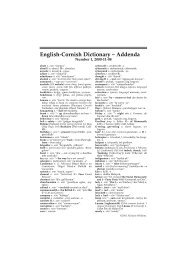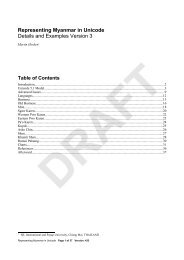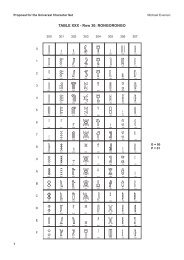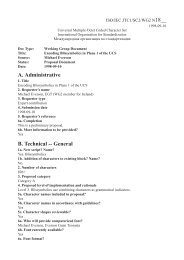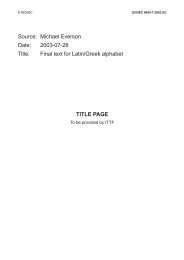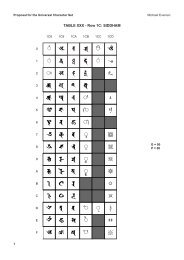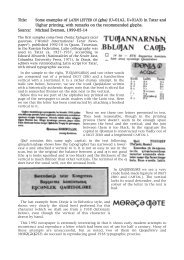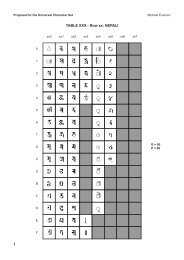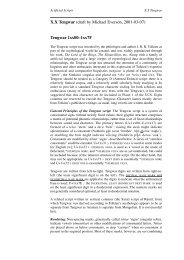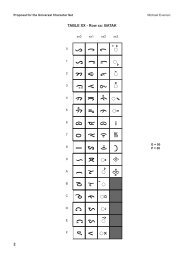open letter to the Irish Minister for Finance - Evertype
open letter to the Irish Minister for Finance - Evertype
open letter to the Irish Minister for Finance - Evertype
Create successful ePaper yourself
Turn your PDF publications into a flip-book with our unique Google optimized e-Paper software.
English Style Guide<br />
12.9 Currency abbreviations. The Publications Office uses a single list, ISO 4217, <strong>for</strong> both OJ work and non-OJ work. The full list,<br />
recommended <strong>for</strong> use in <strong>the</strong> Commission by its Secretariat-General in 1996, can be found online at http://europa.eu.int/comm/<br />
translation/currencies/entable1.htm.<br />
The following table shows <strong>the</strong> names and abbreviations/symbols <strong>for</strong> <strong>the</strong> currencies of <strong>the</strong><br />
EU Member States and some o<strong>the</strong>r countries.<br />
Official name ISO 4217<br />
ECU XEU ( Exception <strong>to</strong> rule: use ECU instead)<br />
euro, pl. euros EUR<br />
Austrian schilling ATS<br />
Belgian franc BEF<br />
German mark DEM<br />
Danish krone, pl. kroner DKK<br />
Spanish peseta ESP<br />
Finnish markka, pl. markkaa FIM<br />
French franc FRF<br />
pound sterling GBP<br />
Greek drachma GRD<br />
<strong>Irish</strong> pound (punt) IEP<br />
Italian lira, pl. lire ITL<br />
Luxembourg franc LUF<br />
Dutch guilder NLG<br />
Portuguese escudo PTE<br />
Swedish krona, pl. kronor SEK<br />
Note also:<br />
Canadian dollar CAD<br />
US dollar USD<br />
Swiss franc CHF<br />
Norwegian krone, pl. kroner NOK<br />
Turkish lira TRL<br />
Japanese yen JPY<br />
12.10 The currency abbreviation precedes <strong>the</strong> amount and takes a space:<br />
FRF 2 400; EUR 3 500; EUR 2 billion<br />
When used, currency symbols are closed up:<br />
$100; £78; €120<br />
12.11 Where a sum is written in words, use <strong>the</strong> <strong>for</strong>m shown in <strong>the</strong> table above: a sum of seven million German marks, two million ecus.<br />
12.12 The euro.<br />
Like 'pound', 'dollar' or any o<strong>the</strong>r currency name, <strong>the</strong> word 'euro' is normally written in lower case with no initial<br />
capital.<br />
In tables and documents where monetary amounts figure largely, make maximum use of <strong>the</strong> abbreviation EUR (be<strong>for</strong>e <strong>the</strong><br />
amount) or <strong>the</strong> € symbol (closed up <strong>to</strong> <strong>the</strong> figure). Note that <strong>the</strong> € symbol is still not used in <strong>the</strong> Official Journal.<br />
Guidelines on <strong>the</strong> use of <strong>the</strong> euro, issued via <strong>the</strong> Secretariat-General, state that <strong>the</strong> plurals of both 'euro' and 'cent' are <strong>to</strong> be<br />
written without 's' in English. Do this when amending or referring <strong>to</strong> legal texts that <strong>the</strong>mselves observe this rule. Elsewhere,<br />
and especially in documents intended <strong>for</strong> <strong>the</strong> general public, use <strong>the</strong> natural plural with 's' <strong>for</strong> both terms.<br />
12.13 Use a point <strong>to</strong> separate units from subunits:<br />
Price: FRF 7.20; BEF 50.-.<br />
http://europa.eu.int/comm/translation/en/stygd/enstyle.htm<br />
2002-03-12 12:46<br />
Page 29 of 70




